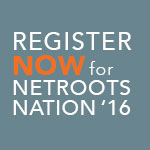After a great run, the Winning the Internet blog has been retired. However, you can still keep in touch with New Media Mentors here.
 One of the things I love about my job is getting to mingle with all kinds of brilliant, creative and driven organizers. I’m a big believer in learning from other activists and taking inspiration from peers, and lucky for us there are some very talented folks working in the progressive space.
One of the things I love about my job is getting to mingle with all kinds of brilliant, creative and driven organizers. I’m a big believer in learning from other activists and taking inspiration from peers, and lucky for us there are some very talented folks working in the progressive space.
For today’s post, I interviewed Elijah Zarlin, Senior Campaign Manager (and expert online organizer) at CREDO Action. Our interview follows.
Q: How did you get your start in email campaigning and what led you to CREDO?
A: Luck and the New Organizing Institute. I applied to NOI’s first online training in 2006, with a vague notion that online campaigning was interesting, and wanting to get more involved in campaigns after a few months of door to door fundraising in Berkeley for John Kerry and the DNC in 2004.
After a week of NOI Bootcamp, I had formal training in a field that everyone suddenly needed on 2006 campaigns, but in which only a handful of people in the country actually had real experience. I knew the nationally relevant campaigns were happening outside of California, and after 2004, Ohio seemed like the center of the political universe. So I applied to work in Ohio and was excited to pack up my truck and drive cross country in the summer of 2006 to be the online organizer for Ted Strickland’s gubernatorial campaign.
I stayed in Ohio, made it to Chicago in 2008 to write emails for the Obama Campaign, and then spent a couple of years in California and DC consulting and freelance writing for a few non-profits. It was often fairly hands off, and frustrating to watch concepts get watered down in layers of approval and internal politics. Then Becky Bond got in touch with me about working on CREDO’s excellent 2010 ballot initiative, the Stop Texas Oil, Hell No on Prop 23 campaign. It was satisfying to be working in a place that so valued organizing and engagement, was quick and nimble, and wasn’t afraid to be unabashedly progressive. They gave me an awesome CREDO track jacket, and the rest is your inbox history.
Q: Fill in the blank. All of the most successful campaigns _______.
A: Have a clear, engaging theory of change. For candidate campaigns, it’s pretty straight forward. For issue campaigns, with multiple decision-makers and possibly multiple decision points, it can be more complex. There are so many things that can make a campaign great: from good data, to good timing, to good art, to good follow up. But at the center of every good campaign is clear communication of why what you are asking someone to is important.
The Obama Campaign in 2008 took it a step beyond most candidate campaigns by really empowering people with the message that not just Obama, but people’s involvement in the process could change things for the better. At CREDO, we launch a lot of different campaigns, but for each one, it needs to be abundantly clear why clicking or calling or writing to the campaign target, at this moment, is the most important way we can make an impact on an issue.
Sometimes, you don’t have to explain it: It’s pretty clear why the Department of Interior shouldn’t allow a huge garbage dump next to Joshua Tree National Park. Other times a bit of context is required. But if it’s not evident almost immediately (“Why am I getting an email about Barn Owls right now?”) or the action doesn’t make sense for the issue (“How will posting a Youtube video effect what Congress does?”) then people don’t engage. If you repeatedly fail to establish a strong theory of change, you lose your credibility with your activists. A strong, clearly communicated theory of change shows people you value their time and activism, and they’re more likely to engage, both on today’s campaign, and the next ones.
Q: Describe your most successful campaign and what made it a hit.
A: I’m proudest of the work we’ve done on Keystone XL. It’s a hard, ongoing campaign, but we’ve definitely made an impact. It started with Bill McKibben’s recognition of an extremely strong theory of change: That the decision to approve a “game over for the climate” pipeline rested almost solely with the President who we had elected on his commitment to fighting climate change. And facing his re-election, pressure from environmentalists would be painful and couldn’t be ignored.
By repeatedly communicating the importance of what had been a relatively unknown issue, we actually got people to travel across the country to DC and get arrested. As an email campaigner, that’s quite satisfying. And despite all conventional wisdom to the contrary, we forced the President to reject the pipeline, although he’s now doing his best to push through as much of it as he can, so we’re still fighting it.
My most enjoyable campaign was actually one of the more frivolous. After the first vote by Congress to repeal Obama’s healthcare law, I found the official federal healthcare plan opt-out form, and had our activists fax it to their representatives who received federal healthcare, but had just voted to deny it to others. The vote itself was purely political. So giving people a very tangible, satisfying response to call out their representative’s hypocrisy proved to be wildly popular. Even hard core activists and wonks need to have a little fun once in a while.
Q: What’s your creative process when working on an email campaign?
A: It totally depends. Sometimes something breaks that is so totally outrageous and urgent that it feels like the email just writes itself, and 90 minutes later, it’s built and sending. Other times, I’m working on an issue that I know is important but can be hard to boil down. I’ll read articles, blog posts, and other email campaigns on the issue to get a clear sense of the relevant points and the best way to frame the action. Sometimes it’ll take a few hours of writing, and 4 or 5 pages of scratch, before I piece together 300-500 words, in a sequence that makes sense. Once an email is built, I almost always make more changes to it, so that it scans clearly in our format. Hip hop and/or folk music, depending on the day, are also essential.
Q: How do you make people care when you’re writing about something that’s important, but not necessarily sexy?
A: Who said policy details weren’t sexy!?! Most people don’t read most emails. So for more complicated issues, it’s important to walk the line between honing in on the essential message or compelling hook that can be communicated instantly, and also providing more context and background, presented in such a way that people can dig in as much or as little as they want.
It’s also a matter of building trust throughout all your campaigns. At CREDO, we’re always talking to other organizers and experts to do our due diligence if the policy details or political situation of a campaign is complicated. We do follow-up on our campaigns when there are developments and victories. And if something urgent is happening, we try to get something out about it quickly. We care a lot about our activists’ experience, online and offline. We find all those things build trust with our activists. So that when we ask them to submit a comment about a Department of Interior coal auction they’ve never heard about before, they trust that it’s important.
The last thing I would say is to be honest. If something is complicated, it’s ok to say that. It’s ok to go into the details. If something is hard – like getting arrested – you should say that. Not all campaigns are the same, and not all campaigns can be explained in a short, urgent email with the subject line “Outrageous!” It might boost action rates in the short term (or it might not), but it doesn’t cultivate informed activists. Ultimately, that’s the broader measure of success.




Trackbacks/Pingbacks
[…] in August, we talked to CREDO’s Elijah Zarlin about successful organizing. In his interview, he talks a lot about theory of change and the logic model of organizing. At CREDO, we launch a lot […]